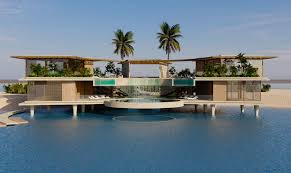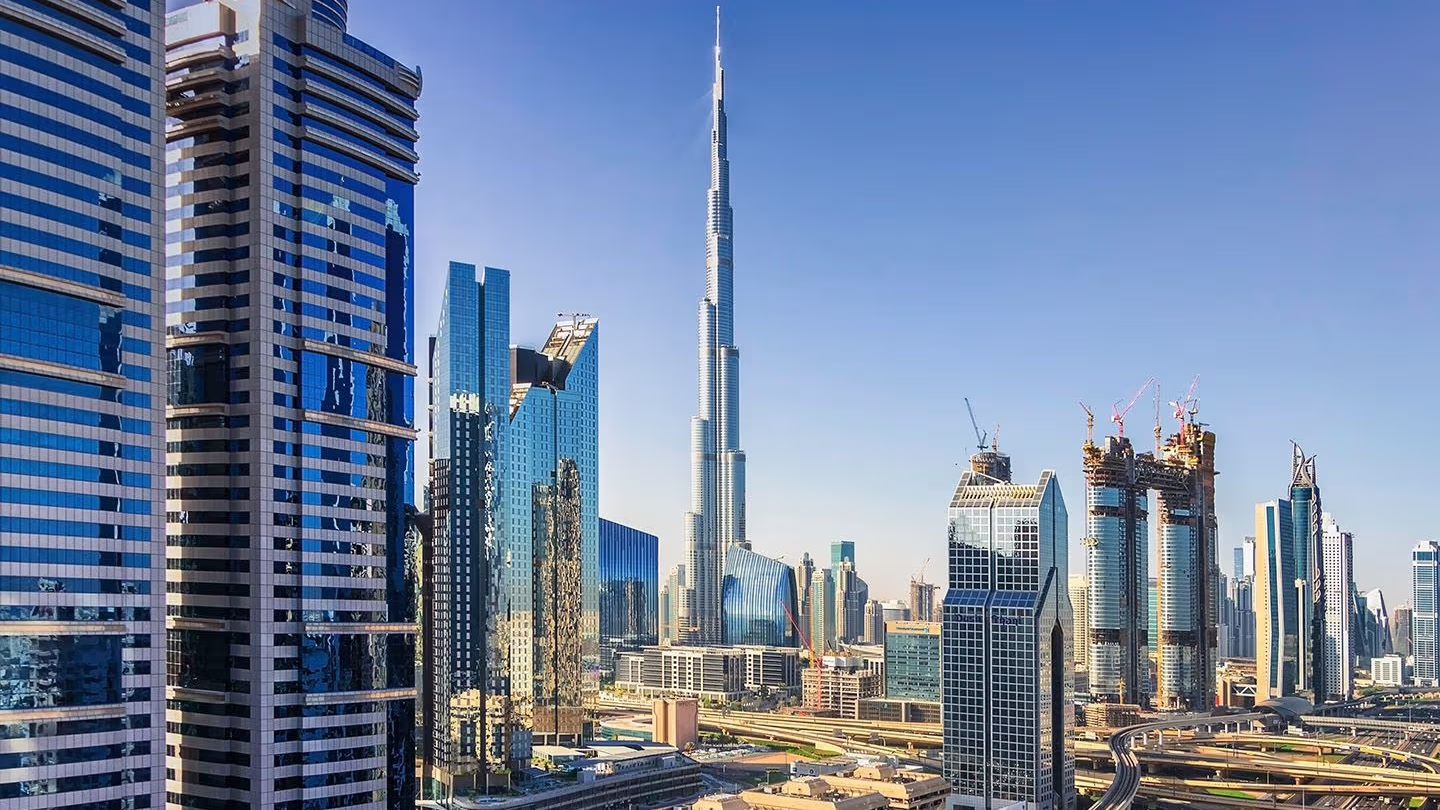Now Reading: Island Villas in Dubai: The Ultimate Combination of Privacy and Luxury
-
01
Island Villas in Dubai: The Ultimate Combination of Privacy and Luxury
Island Villas in Dubai: The Ultimate Combination of Privacy and Luxury

Table of Contents
Imagine waking in a sprawling villa, your smart home gently parting the curtains to reveal a private beach where turquoise waves kiss the shore. You savor coffee on a secluded terrace, spend the afternoon lounging by your infinity pool, or sail out from your personal marina, all within the embrace of an exclusive island retreat. In 2025, Dubai’s island villas Palm Jumeirah, The World Islands, and Palm Jebel Ali are redefining luxury living with unparalleled privacy and opulence.
These properties are fueling Dubai’s real estate surge, with 96,000 transactions worth $87 billion in the first half, 58% driven by buyers from the UK, India, Russia, and China. Offering 100% freehold ownership, a dirham pegged to the U.S. dollar, and no personal income tax, capital gains tax, or annual property taxes, these villas priced from $3 million to $12 million deliver 6-8% rental yields and 8-12% price appreciation, outpacing London (2-4%) and New York (2-3%).
Properties over $545,000 qualify for a 10-year Golden Visa, while smaller units grant 2-year residency. Powered by 25 million tourists and a 4% population surge, these island havens blend private marinas, smart technology, and bespoke amenities to create homes that are as lucrative as they are serene. Navigating fees, VAT, and 2025 regulations is key to securing your stake in these radiant coastal sanctuaries.
Unmatched Privacy in Coastal Paradise
Dubai’s island villas, nestled on Palm Jumeirah’s iconic fronds, The World Islands’ private atolls, and Palm Jebel Ali’s reborn shores, offer seclusion just 15-35 minutes from Dubai International Airport via Sheikh Zayed Road or water taxis. With vacancy rates of 1-2% compared to 7-10% globally, these $3 million-$12 million villas yield $180,000-$720,000 annually, tax-free, saving $66,600-$324,000 versus the U.S. (37%) or UK (45%).
Selling a $3 million villa for $3.6 million (20% appreciation) delivers a $600,000 tax-free profit, saving $120,000-$168,000 compared to London (20-28%) or New York (20-37%). No property taxes save $30,000-$120,000 yearly, unlike London’s council tax (up to 2%) or New York’s property tax (1-2%). Residential purchases skip 5% VAT ($150,000-$600,000), and features like private beaches and gated access drive 8-12% price growth, attracting high-net-worth buyers seeking exclusivity.
Living here feels like a serene embrace of coastal solitude.
No Personal Income Tax: Rentals That Thrive
Dubai’s no personal income tax policy lets you keep 100% of rental income, unlike the U.S. (up to 37%) or UK (up to 45%). A $3 million World Islands villa yields $180,000-$240,000, saving $66,600-$108,000; a $12 million Palm Jebel Ali villa yields $540,000-$720,000, saving $243,000-$324,000.
Short-term rentals, fueled by 25 million tourists visiting Palm Jumeirah’s beach clubs or The World Islands’ resorts, require a DTCM license ($408-$816), boosting yields by 10-15% ($18,000-$108,000). Long-term leases, ideal for families seeking private retreats, need Ejari registration ($54-$136). Non-compliance risks fines up to $13,612, so licensing is crucial. Private docks, infinity pools, and smart concierges enhance rental appeal, aligning with 2025’s luxury trends and driving 85-90% occupancy.
Tax-free rentals feel like a golden tide of prosperity.
Zero Capital Gains Tax: Profits That Soar
Zero capital gains tax lets you keep 100% of sale profits. Selling a $3 million World Islands villa for $3.6 million yields a $600,000 tax-free profit, saving $120,000-$168,000 versus London (20-28%) or New York (20-37%). A $12 million Palm Jebel Ali villa sold for $14.4 million delivers a $2.4 million tax-free gain, saving $480,000-$672,000.
With 8-12% price growth driven by island exclusivity, these villas outperform global markets, where similar homes rarely exceed $8 million. A 4% DLD fee ($120,000-$480,000), often split, applies, but tax-free profits make these properties wealth-building powerhouses.
Keeping every dirham feels like a radiant financial triumph.
No Annual Property Taxes: Ownership That Feels Light

Unlike global markets, these islands impose no annual property taxes, saving $30,000-$120,000 yearly on $3 million-$12 million villas compared to London’s council tax ($60,000-$240,000) or New York’s property tax (1-2%). Maintenance fees ($20,000-$70,000) cover private beaches, smart security, and 24/7 concierge, aligning with ultra-luxury standards. A 5% municipality fee on rentals ($9,000-$36,000) is reasonable for these prime coastal locations. These low costs make ownership sustainable, supporting a lifestyle that feels private and opulent, perfectly suited to 2025’s island vision.
No property taxes feel like a gentle breeze lifting your investment.
VAT Rules: A Savvy Investor’s Edge
Residential purchases skip 5% VAT, saving $150,000-$600,000 on $3 million-$12 million villas, unlike commercial properties or the UK’s stamp duty (up to 12%, or $360,000-$1.44 million). Off-plan purchases, common in Palm Jebel Ali, incur 5% VAT on developer fees ($30,000-$120,000), recoverable via Federal Tax Authority (FTA) registration ($500-$1,000).
Short-term rental operators must register for VAT if revenue exceeds $102,041, charging 5% but claiming credits on DTCM fees ($408-$816). A $3 million villa yielding $180,000-$240,000 incurs $9,000-$12,000 in VAT, with $1,500-$2,000 in credits; a $12 million villa yielding $540,000-$720,000 incurs $27,000-$36,000 in VAT, with $3,000-$4,000 in credits. Non-compliance risks fines up to $13,612, so meticulous records are key.
VAT exemptions feel like a clever spark in your savings.
DLD Fees and Title Deeds: Securing Your Island Sanctuary
The 4% DLD fee, typically split, applies: $120,000 for a $3 million villa or $480,000 for a $12 million villa. Gift transfers to family or shareholders reduce DLD to 0.125%, saving $116,250-$465,000. For example, gifting a $12 million villa cuts DLD from $480,000 to $15,000. Title deed issuance costs $136-$272, requiring DLD registration. Broker fees, typically 2% ($60,000-$240,000), may be waived for off-plan projects like Palm Jebel Ali’s new villas. Mortgage registration (0.25% of the loan, or $7,500-$30,000) and valuation fees ($680-$1,360) apply for financed deals. The 2025 Oqood system ensures escrow compliance for off-plan purchases, protecting your investment.
Title deeds feel like the key to your private coastal haven.
Corporate Tax: A Business Buyer’s Note
Introduced in 2023, the 9% corporate tax applies to businesses with profits over $102,110. A company leasing a $3 million villa yielding $180,000-$240,000 faces a 9% tax ($16,200-$21,600), reducing net income to $163,800-$218,400. A $12 million villa yielding $540,000-$720,000 incurs $48,600-$64,800 in tax.
Qualified Free Zone Person (QFZP) status in areas like DMCC avoids this, saving $16,200-$64,800, with setup costs of $2,000-$5,000. Small business relief waives corporate tax for revenues under $816,000 until December 31, 2026. Individual ownership skips this tax, ideal for most investors.
Corporate tax feels like a soft ripple you can navigate.
New Tax Rules for 2025
The Domestic Minimum Top-up Tax (DMTT), effective January 1, 2025, imposes a 15% tax on multinationals with revenues over €750 million ($793 million). Individual investors and smaller entities are unaffected, and QFZP status avoids DMTT, saving $16,200-$108,000. Cabinet Decision No. 34 refines Qualifying Investment Fund (QIF) rules, exempting corporate tax if real estate income is below 10%. A QIF earning $1 million, with $100,000 from rentals, faces 9% tax ($8,100) on 90% ($900,000). A July 2025 policy allows corporate tax deductions on fair market value depreciation, saving $5,455-$21,818 annually for a $3 million villa revalued at $3.6 million. These rules enhance the appeal of Dubai’s island villas.
New tax rules feel like a puzzle with prosperous solutions.
Top Island Villa Destinations in 2025
1. Palm Jumeirah: Iconic Coastal Retreat
Palm Jumeirah ($3 million-$8 million) offers 6-8% yields and 8-12% price growth, featuring villas with private marinas and wellness clubs. A $3 million villa yields $180,000-$240,000 tax-free, saving $66,600-$108,000. Selling for $3.6 million yields a $600,000 tax-free profit, saving $120,000-$168,000. No property taxes save $30,000-$80,000, and VAT exemption saves $150,000-$400,000. Maintenance fees are $20,000-$50,000, with a 5% municipality fee ($9,000-$12,000). QFZP saves $16,200-$21,600. U.S. investors deduct depreciation ($54,545-$145,455), saving up to $50,909. Its iconic allure draws global elites.
Palm Jumeirah feels like a radiant, nautical masterpiece.
2. The World Islands: Exclusive Private Haven
The World Islands ($4 million-$10 million) offers 6-8% yields and 8-12% price growth, featuring villas on private islands with bespoke amenities. A $4 million villa yields $240,000-$320,000 tax-free, saving $88,800-$144,000. Selling for $4.8 million yields an $800,000 tax-free profit, saving $160,000-$224,000. No property taxes save $40,000-$100,000, and VAT exemption saves $200,000-$500,000. Maintenance fees are $25,000-$60,000, with a 5% municipality fee ($12,000-$16,000). QFZP saves $21,600-$28,800. U.S. investors deduct depreciation ($72,727-$181,818), saving up to $63,636. Its secluded exclusivity attracts ultra-high-net-worth buyers.
The World Islands feels like a serene, elite sanctuary.
3. Palm Jebel Ali: Reborn Luxury Oasis
Palm Jebel Ali ($5 million-$12 million) offers 6-8% yields and 8-12% price growth, featuring 550 new villas with private beaches and infinity pools. A $5 million villa yields $300,000-$400,000 tax-free, saving $111,000-$180,000. Selling for $6 million yields a $1 million tax-free profit, saving $200,000-$280,000. No property taxes save $50,000-$120,000, and VAT exemption saves $250,000-$600,000. Maintenance fees are $35,000-$70,000, with a 5% municipality fee ($15,000-$20,000). QFZP saves $27,000-$36,000. U.S. investors deduct depreciation ($90,909-$218,182), saving up to $76,364. Its reborn grandeur draws high-net-worth investors.
Palm Jebel Ali feels like a vibrant, coastal haven.
Why These Villas Shine
Price Range: Palm Jumeirah ($3 million-$8 million) and The World Islands ($4 million-$10 million) suit high-end buyers; Palm Jebel Ali ($5 million-$12 million) targets ultra-luxury investors.
Rental Yields: 6-8%, with Palm Jebel Ali at 6-8% for short-term rentals; others at 6-7% for stable leases.
Price Appreciation: 8-12%, driven by privacy and global demand.
Lifestyle: Private beaches, marinas, and smart systems create exclusive living.
Amenities: Infinity pools, wellness clubs, and concierge services enhance appeal.
ROI Verdict: 8-12% ROI, blending privacy with stellar returns.
Investing here feels like embracing a radiant, secluded legacy.
Strategies to Maximize Returns

For individuals: Hold properties personally to avoid corporate taxes, saving $16,200-$64,800. Negotiate DLD fee splits, saving $60,000-$240,000. Use gift transfers to reduce DLD to 0.125%, saving $116,250-$465,000. Recover 5% VAT on developer fees via FTA registration ($500-$1,000). Leverage double taxation treaties with 130+ countries, saving $66,600-$324,000. U.S. investors deduct depreciation ($54,545-$218,182), saving up to $76,364. For corporates: Secure QFZP status, keep QIF income below 10%, and claim depreciation deductions. Hire property managers ($20,000-$70,000 annually) and tax professionals ($1,000-$3,000) to avoid fines up to $136,125. Focus on short-term rentals in Palm Jebel Ali, long-term in The World Islands.
These strategies feel like a treasure map to your private wealth.
Risks to Watch in 2025
A projected oversupply of 182,000 units by 2026 may slightly slow price growth in newer Palm Jebel Ali phases, but Palm Jumeirah and The World Islands remain resilient due to their established allure. Off-plan delays risk setbacks, so choose trusted developers like Nakheel and verify escrow compliance via the 2025 Oqood system. Non-compliance with VAT or DTCM rules risks fines up to $13,612, and corporate tax errors can cost $136,125. Indian investors must report properties in India’s Foreign Asset schedule to avoid $135,000 penalties. Currency fluctuations, though minimal with the dollar peg, could impact returns.
Why Island Villas Are Worth It
With 8-12% ROI, 8-12% growth, and tax-free savings of $30,000-$720,000 annually, Dubai’s island villas Palm Jumeirah, The World Islands, and Palm Jebel Ali offer private residences, luxurious amenities, and global appeal. Golden Visa perks, 85-90% rental occupancy, and a lifestyle blending seclusion with profitability make them 2025 investment gems. Navigate fees, secure your island haven, and invest in Dubai’s radiant future.
read more: Luxury Waterfront Living in Dubai Marina’s New 2025 Developments






















